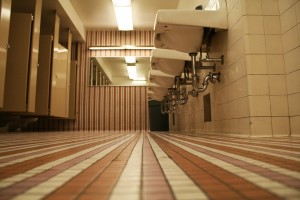Potty politics: Why women are pissed off about restrooms
Features — By Sarah Karon“It’s just a matter of changing the sign on the door,” Brubaker says. “It creates inherent parity because the next available toilet becomes available to the next person in line.”
Single stall unisex toilets also make things easier for families. A father traveling with his young daughter, for example, needn’t decide between sending her into the women’s bathroom alone or taking her into the men’s room. Family toilets are also useful for people with disabilities, who may need help from opposite-gender partners.
Unisex bathrooms have won fans among gay, lesbian and transgender communities, too.
“It’s really an issue of comfort and safety,” says Gabe Peeples, a coordinator at the LGBT Campus Center at UW. “Say someone looks masculine but identifies as feminine. People can feel threatened if someone who looks like a man enters a women’s restroom.”
Currently there are 19 gender-neutral bathrooms in campus buildings at UW-Madison, according to a list Peeples maintains for the LGBT Campus Center’s website.
“It’s not nearly enough,” he says. “I think every building on campus should have at least one. Some professors and students spend all day in one building.”

"A bathroom upgrade … should be considered part of our nation’s infrastructure improvement," Anthony says. Photo by Anna Quinn
New buildings on the university’s campus, including University Square and Union South, typically include unisex toilets. But the university usually does not retrofit older buildings with unisex bathrooms, says Gary Brown, the university’s director of campus planning and landscape architecture.
One reason is cost.
“It’s quite a large investment to bring an old building up to a new code,” says Julie Grove, an architect and project manager at UW. She points out that simply adding a new sink to an older bathroom can significantly affect the entire project’s budget, because the plumbing renovation requires that the bathroom meet new building codes.
Some architects argue that unisex toilets, while convenient, are inefficient compared to multi-person facilities.
Grace La, a Milwaukee architect, has worked on several projects involving unisex restrooms, including the Hillel Center at the UW-Milwaukee. La says unisex restrooms make sense in certain spaces, especially if they maximize efficiency and help “provide greater sensitivity to transgendered individuals.” But, she argues, a series of unisex stalls instead of a communal facility sometimes doesn’t make sense.
“You’re building more walls between shared spaces, and you’re not optimizing the potential for two toilets to share one sink,” La says. “You simply aren’t going to be able to share the kind of efficiencies that you get in multi-person restrooms.”
She adds: “Do I love beautiful bathrooms? Yes. But you could argue that [unisex restrooms] represent a kind of excess.”
Excess or no, advocates like Kathryn Anthony will continue to push for more bathrooms. In May Anthony testified at a Congressional hearing for the Restroom Gender Parity in Federal Buildings Act, popularly known as — what else — the Potty Parity bill. If passed, the bipartisan legislation will require the number of women’s toilets in renovated and newly built federal buildings to equal or exceed the number of men’s facilities. The bill is still in committee and no vote has been scheduled.
“There are a lot of other important issues in Congress, obviously,” Anthony concedes. “But it would be the first time we would have any federal legislation on this issue. A bathroom upgrade … should be considered part of our nation’s infrastructure improvement.”
She pauses. A note of playful righteousness creeps into her voice.
“Potty parity is an issue that’s near and dear to the hearts and bladders of people all over the world.”
Tags: Karon, Potty




 Digg This
Digg This Bookmark
Bookmark Stumble
Stumble